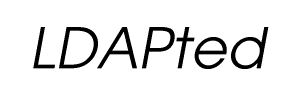


|

|
LDAPted is a web platform to browse a LDAP-based Server and to edit single entries through a set of task specified forms. This multilingual tool uses XML and object-oriented techniques. The GUI is easily customizable by designing new HTML templates.
Project HomepageThe LDAPted project is hosted by Sourceforge. They really provide a great service.
GNU gettextThe application was developed by using the GNU gettext framework. Its native language is English and a translation to German is already made. But a localisation to another region is easily to fulfil. There is only a text file with messages in English which have to translate in the new language. For any translating support we are very thankful.
XML Forms
This application doesn't want to give a 1:1 representation of a LDAP entry. Individual forms can be defined in a XML-file to edit an entry.
Examples can be found here.
Templates
LDAPted is programmed by using the HTML-template class. In case your are not happy with the existing GUI you can easily design your own one without changing the PHP source code. Just create new HTML-template files.
System Requirements
In case of LDAPted you have to differ between the system requirements of the server enviroment and the client side.
On the client side are normal web browser like Mozilla or the internet explorer. Due to javascript-'schnick schnack' we used, LDAPted require an internet explorer with the version equal to or higher than 5.5. Every version of Mozilla equal to or higher than the first stable Release (1.0 Version) is fine as well. But we are sorry for not supporting other web browser like Operal ('The fastest web browser world wide ;-)').
An online demo is available at:
https://www.pbdemo.de/ldapted/login.php
It represents a current developer version of the LDAPted software. Bugs can't be barred...
Feel free to experiment with this system.
For a release please visit the 'File Section' at the LDAPted project page. Decompress the archieve to a location accessible by your web server. You'll find an installation guide inside the archieve to adapt the proper changes to the configuration files.
Kabramps Team|
|